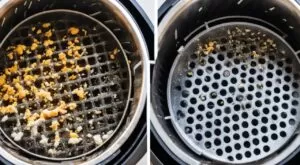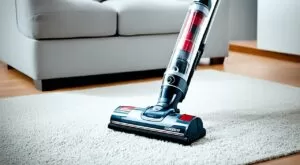Washing machines are key to keeping our clothes clean and smelling fresh. But, they can also be a home for mold and mildew. Things like warm temperatures, dirt from clothes, and residue from detergents can make mold grow. This is especially true for front-loading machines.
But don’t worry, getting rid of mold and residue in your washing machine is easy. This guide will show you how to make your machine clean and free of mold again. You’ll learn simple ways to keep your appliance fresh and mold-free.

Key Takeaways
- Mold can thrive in warm, humid conditions, making washing machines a prime target
- High-efficiency front-loading washers are particularly prone to mold contamination
- Bleach, vinegar, and baking soda are effective solutions for removing mold and residue
- Regular maintenance, including monthly cleaning, can help prevent mold growth
- Proper ventilation and avoiding excessive detergent use are key to mold prevention
What Causes Mold Growth in Washing Machines?
Washing machines can become perfect spots for mold to grow. This happens when warm temperatures, moisture, and organic stuff come together. These conditions make it easy for mold to spread, causing ugly and harmful growth in your laundry machine.
Warm Temperatures and Moisture
Mold loves warm, humid places. In the summer, when it gets hot and laundry rooms don’t get enough air, washing machines become ideal for mold. The warm temperatures and moisture from washing help mold spores grow and spread.
Detergent and Fabric Softener Residue
Buildup of detergent and fabric softener residue also leads to mold growth in washing machines. These products leave behind food for mold, helping it grow. High-efficiency (HE) washers are especially at risk because their special detergents leave a lasting film.
Dark and Humid Environment
The dark, closed space of the washing machine drum, along with the humid conditions, is perfect for mold. Mold spores can easily settle and grow in these damp, dark spots, causing harmful and ugly growth.
Keeping your washing machine clean is key to stopping mold. By dealing with moisture, detergent buildup, and bad ventilation, you can keep your machine clean and mold-free. This ensures a healthy laundry space.

Preparing to Clean Moldy Washing Machine
Before you start cleaning your washing machine, make sure it’s ready. First, run an empty wash cycle to clear the drum. This ensures it’s empty and ready for cleaning. If your washer has an automatic detergent or fabric softener dispenser, empty it too. This prevents clothes from getting bleached by mistake.
Next, collect the cleaning tools you’ll need. You’ll need a microfiber cloth, a soft-bristled scrub brush, and protective gloves. These items help you remove mold and residue safely while protecting your hands from harsh chemicals.
- Run an empty wash cycle to clear the drum.
- Check and empty the automatic detergent or fabric softener dispenser.
- Gather the necessary cleaning supplies: microfiber cloth, soft-bristled scrub brush, and protective gloves.
By following these steps, you’re all set to remove mold from your washing machine. Your machine will be clean and ready for the next load of laundry.
Using Chlorine Bleach to Remove Mold
Chlorine bleach is a top choice for killing mold in washing machines. Start by adding one cup or more of chlorine bleach to the washer drum. Or, use 1/2 cup for mold removal in the washer. Run a full wash cycle with the hottest water to kill mold in hard-to-reach places.
Consumer Reports says washing machines can pick up mold spores and other debris. Front-loading machines are more likely to get mold than top-loading ones, as noted by prohousekeepers.com. For cleaning rubber seals and trays, mix 1/4 cup of bleach with 2 cups of water.
- Run the washer on the hottest water setting with a full load of towels or other heavy items.
- Add 1 cup of chlorine bleach directly to the drum or detergent dispenser.
- Let the bleach solution circulate for at least 1 hour before draining the machine.
- After the cycle, wipe down the drum, gasket, and other areas with a microfiber cloth to remove mold or mildew.
By following these steps to disinfect washer with bleach, you can get rid of mold and make your washing machine clean again. Keeping up with regular maintenance and cleaning will help stop mold from coming back and keep your appliance working well.
Cleaning with Vinegar and Baking Soda
If you don’t like chlorine bleach, vinegar and baking soda work well to remove mold from washing machines. This green way to clean is great for those who want to avoid harsh chemicals. It can be used alone or with bleach to clean and kill germs in the washer.
Vinegar and Borax Solution
Putting a gallon of white vinegar and a pound of borax in a hot wash cycle can kill mold in the drum and hoses. Borax is a natural cleaner and germ killer. It works great with vinegar to fight mold.
Baking Soda and Vinegar Cycle
Or, add a cup of baking soda to the drum and vinegar to the detergent tray. Then, run a hot cycle. This mix of baking soda and vinegar breaks down mold and dirt. The reaction between them cleans out grime and smells.
These natural mold removal methods for laundry appliances are easy and effective. They help disinfect your washing machine without harsh chemicals. Using homemade solutions to clean your washer keeps your clothes fresh and your machine mold-free.
Guide to Removing Mold and Residue from the Washing Machine
This guide offers step-by-step instructions for getting rid of mold and residue in your washing machine. By using these methods, you can clean and keep your laundry smelling fresh.
To effectively remove mold, run a hot wash cycle with chlorine bleach. Experts suggest adding two cups of bleach to the detergent tray of a front-loader. For top-loaders, use four cups of bleach in the drum for a thorough clean.
Or, try a natural mix of white vinegar and baking soda to fight washer mold and residue. Mixing vinegar and baking soda in the washing machine makes a strong, green cleaner. It gets rid of dirt, grime, and bad smells. Make sure to mix them in the washing machine basket for the best effect.
| Cleaning Method | Effectiveness | Suitable for |
|---|---|---|
| Chlorine Bleach | Highly Effective | Front-loaders (2 cups), Top-loaders (4 cups) |
| Vinegar and Baking Soda | Highly Effective (75% effectiveness) | All Washing Machines |
By using this comprehensive guide to cleaning mold from washing machines, you can remove mold and residue easily. Follow the step-by-step instructions for mold removal in laundry appliances. This will help you get a complete process for eliminating washer mold and residue. Regular cleaning and maintenance will stop mold from coming back, keeping your washing machine in top shape.
Preventing Future Mold Growth
Keeping your washing machine clean is key to stopping mold from coming back. By following a regular maintenance routine, you can keep your washer working well and reduce mold risks. Here are some important tips to help you avoid mold:
- Leave the door and detergent tray open after each use to let air in and dry out the machine, which stops mold from growing.
- Wipe down the door gasket and other damp parts of the washing machine often to get rid of moisture.
- Run a self-cleaning or hot water cycle every month to clear out any leftover residue or mold spores.
- Use the right amount of high-efficiency detergent and don’t use too much fabric softener, as they can lead to residue that mold likes.
- Improve ventilation and humidity control in the laundry room to make it less likely for mold to grow. Try to keep humidity between 30 and 50 percent.
By sticking to these tips, you can prevent mold in washing machines and keep your washer mold-free for a long time. Paying attention and being proactive in maintaining a clean laundry appliance ensures a mold-free washing experience.
Conclusion
This guide has shown you how to get rid of mold and residue in washing machines. It also shared ways to stop mold from coming back. Using things like chlorine bleach, vinegar, and baking soda can help. These methods can remove tough mold and keep your washing machine clean.
It’s important to clean your machine regularly. Make sure you use the right amount of detergent. Also, make sure there’s good air flow to stop mold from growing. This way, your washing machine will stay mold-free for a long time.
Keeping your laundry appliance clean means watching out for mold and using natural cleaners like vinegar and baking soda. By following this guide, you can get rid of washer mold and residue. This ensures your washing machine works well and stays clean for years.
With the right care, your washing machine can stay mold-free and work better. By using these tips, you’ll have a clean, fresh-smelling machine. It will meet all your cleaning needs perfectly.
FAQ
What causes mold growth in washing machines?
Mold grows in the warm, moist, and dark inside of washing machines. Warm temperatures, humidity, and soil and bacteria from clothes create a perfect environment. Detergent and fabric softener residue also feed mold.
How do I prepare my washing machine for mold removal?
First, run an empty wash cycle to clear the drum. Empty any automatic detergent or fabric softener dispensers too. This avoids bleaching clothes by mistake.
What is the most effective way to remove mold from my washing machine?
Chlorine bleach is great for killing mold in washing machines. Put one cup or more of bleach in the drum or 1/2 cup in the detergent spot. Use the hottest water for a full wash cycle to clean the whole system.
Can I use vinegar and baking soda instead of bleach to clean my washing machine?
Yes, vinegar and baking soda work well against mold too. Run a gallon of vinegar and a pound of borax on a long, hot cycle. Or, use a cup of baking soda and vinegar in the detergent tray for a hot cycle to clean.
How can I prevent mold from returning to my washing machine?
To stop mold from coming back, keep up with cleaning and maintenance. Leave the door and detergent tray open to air out and dry. Clean the door gasket and damp areas, and run a hot cycle monthly. Use the right amount of detergent and less fabric softener to reduce residue.





